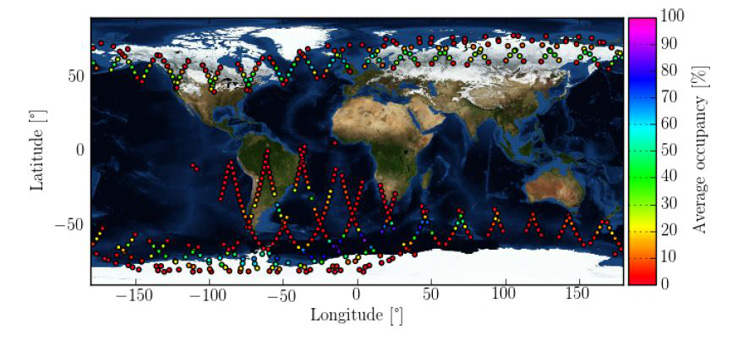Overview
The team behind the satellite-based LUCID experiment have run GEANT4 simulations of their detectors on the Grid in order to better understand the data collected since its 2014 launch aboard Surrey Satellite Technology Limited’s TechDemoSat-1.
The problem
The Langton Ultimate Cosmic ray Intensity Detector (LUCID) experiment uses five Timepix detectors to measure properties of the space radiation environment in Low Earth Orbit (LEO). These detectors, developed by the Medipix Collaboration at CERN, can measure the flux, direction and energy of incident ionising radiation using silicon pixel technology developed for the LHC. LUCID was designed by students from the Simon Langton School for Boys (Canterbury, UK) and built by Surrey Satellite Technology Limited (SSTL), and is one of the research projects associated with the CERN@school programme.
As with most modern particle physics experiments, a GEANT4 simulation of LUCID was developed in order to understand the performance of the experiment in the wide range of radiation environments to which it would be exposed. These included the outer electron belts of the Polar Regions and the South Atlantic Anomaly (SAA). The number of simulations required to produce reliable statistics was far beyond what the school computing infrastructure could provide and so it was decided to use the Grid.
The solution
The GEANT4 simulation of LUCID, built with the Medipix Collaboration’s Allpix software suite, was compiled on a Grid-compatible SLC6 machine and deployed using the CERN@school CernVM-FS software repository hosted on RAL’s Stratum-0. After determining the number of simulations required, based on the relevant points on LUCID’s orbit and the expected particle fluxes from the AP8 (AE8) proton (electron) models, GEANT4 parameter input files were generated and used to submit thousands of jobs to the Grid using the Imperial DIRAC instance. Around 500 orbital points were simulated per run, modelling the interactions of around 5 million source particles per orbital point. Data was stored and managed using the DIRAC File Catalog, with prompt retrieval and analysis made possible using DIRAC’s metadata functionality. The results were presented at the International Workshop on Radiation Imaging Detectors 2014 and can be seen here.
What they said
“Without the Grid, and the fantastic support from the GridPP community, we simply wouldn’t have been able to get the results we needed to understand our experiment. Software deployment was made trivial by using our CernVM-FS repository and the web interface provided by the Imperial DIRAC instance allowed our jobs to be monitored easily, greatly reducing the stress we faced with a tight publishing deadline. Thank you GridPP!”
Further details
Services used
- DIRAC: for Grid job submission and management;
- DIRAC File Catalog (DFC): for data storage and metadata management;
- CernVM: for creating a User Interface to the Grid and software testing;
- CernVM-FS: for software deployment and management.
Supporting GridPP sites
- Glasgow
- Liverpool
- Queen Mary University of London
Virtual Organisation(s)
Publications
- T. Whyntie and M. A. Harrison, “Full simulation of the LUCID experiment in the Low Earth Orbit radiation environment“, JINST 10 C03043 (2015).

